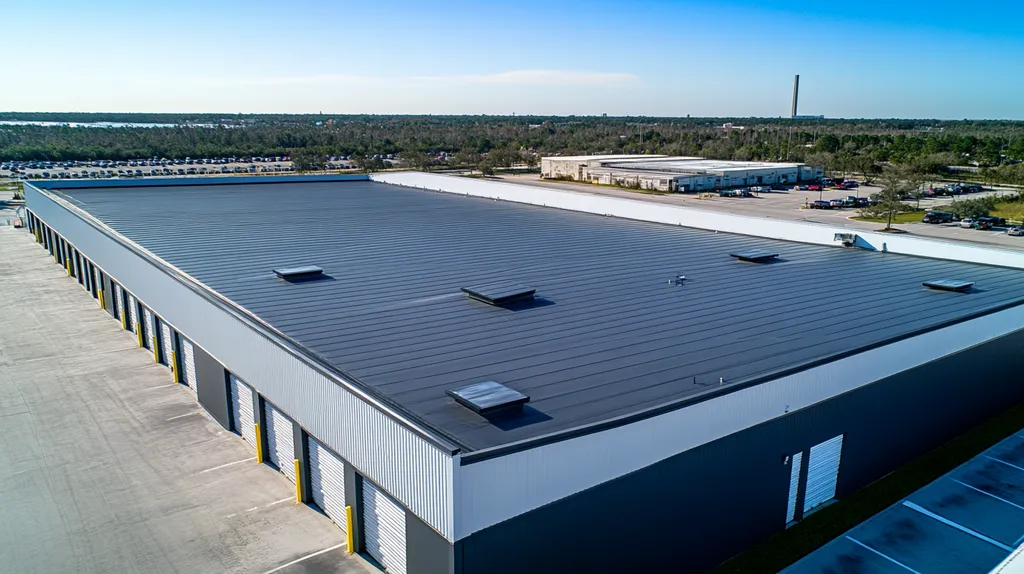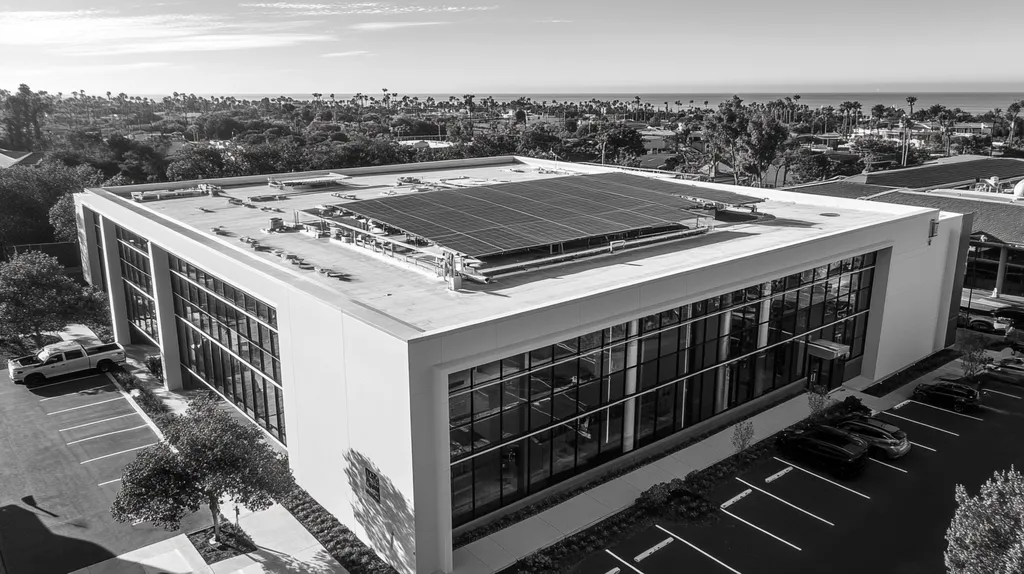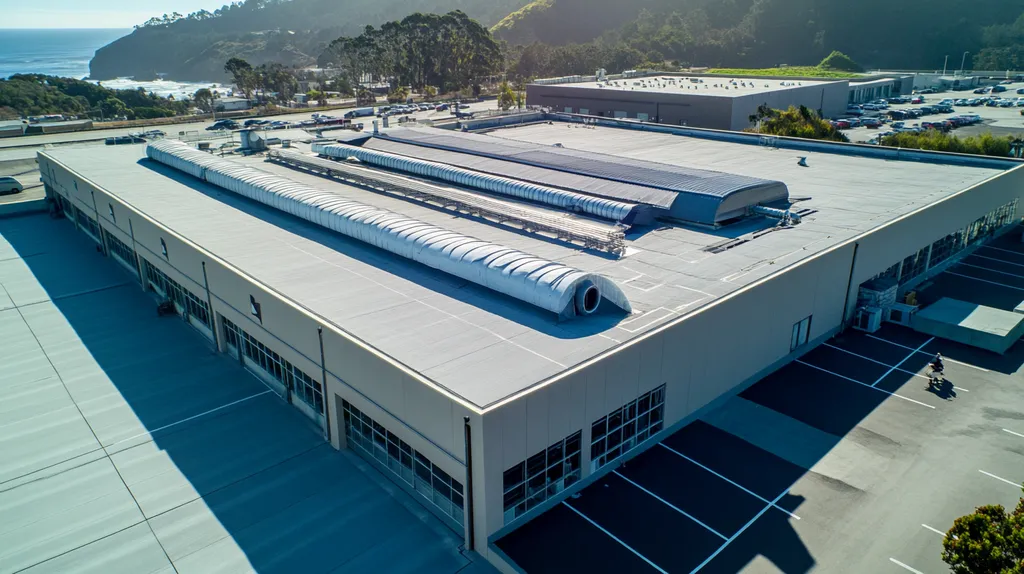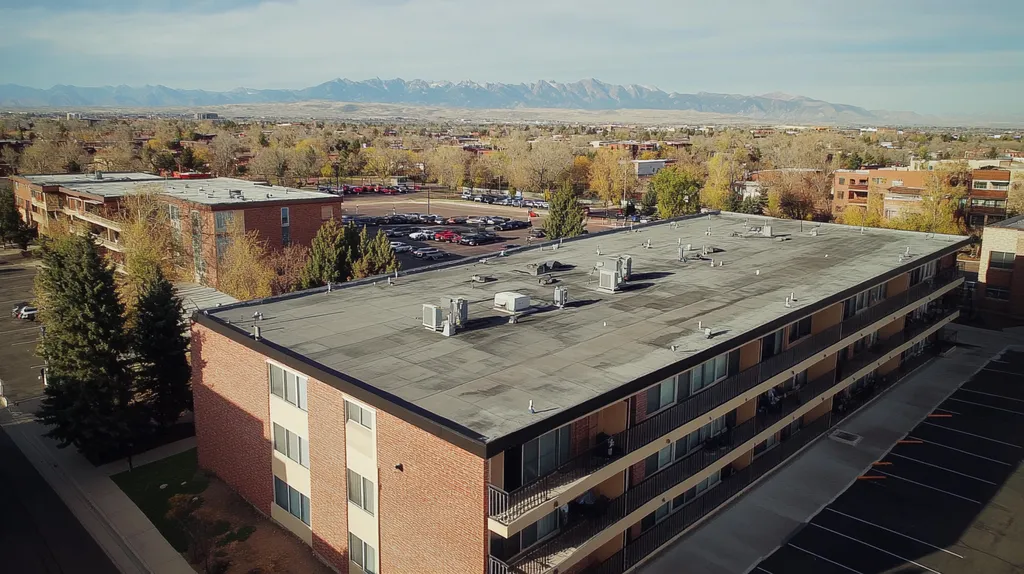In today’s challenging economic climate, labor costs can make or break an industrial roof coating project. Studies show that inefficient labor management can inflate project expenses by up to 40%, directly impacting a facility’s bottom line.
From material selection to application techniques, understanding the key elements that drive labor efficiency has become crucial for property owners and facility managers.
This comprehensive guide examines six critical areas where smart planning and informed decisions can significantly reduce labor costs while maintaining quality standards in industrial roof coating projects.
SECTION 1: THE BASICS EXPLAINED
Understanding the fundamentals of industrial roof coating projects is essential for commercial property owners and facility managers. The stakes are high: managing your roof improperly can lead to costly repairs, a shorter building lifespan, and skyrocketing energy bills. In fact, research shows that inadequate roofing maintenance can inflate operational costs by as much as 30%. This section breaks down what roof coatings are, why they matter, and how they work, shedding light on this vital yet often overlooked aspect of building maintenance.
What It Is (In Plain Language)
Industrial roof coatings are special materials applied to roofs designed to boost durability and performance. Think of them as a protective shield against the harsh elements, including UV rays, rain, and extreme temperatures. With proper maintenance, these coatings can significantly extend a roof’s lifespan, often lasting more than 20 years.
Generally made from materials like acrylic, silicone, or polyurethane, each coating type has distinct advantages for differing environments. For instance, silicone is well-known for its waterproofing abilities, while acrylic coatings offer excellent thermal reflection, making them great for energy savings.
One of the key benefits of roof coatings is that they can often be added directly over existing roof materials, minimizing disruption and avoiding the lengthy processes involved in traditional roof replacement.
Grasping these properties is vital for making informed choices regarding roof maintenance and upgrades within commercial and industrial settings.
Why It Matters (To Your Building)
Roof coatings do more than enhance aesthetics; they are critical for long-term asset management. A well-coated roof can prevent leaks that lead to interior damage and costly repairs, while also lowering the risk of premature roof replacement.
Furthermore, roof coatings can help enhance energy efficiency. Many coatings reflect sunlight, thus reducing heat absorption, which can lead to substantial cooling cost savings during hot months. By investing in energy-efficient roofing, property owners can lower utility bills while also improving the overall comfort of their buildings.
Moreover, maintaining a well-kept roof can increase property value. Owners who prioritize roof maintenance and coatings demonstrate a commitment to sustaining their asset, making it more attractive to potential buyers.
In summary, recognizing the direct benefits of roof coatings highlights their essential role in building management and reinforces the need for proactive maintenance.
How It Works
The effectiveness of roof coatings hinges on both their application and the technology behind them. The process starts with thoroughly cleaning the existing roof surface to ensure optimal adhesion. Any necessary repairs should also be completed prior to applying the coating.
After preparing the roof, the coating is typically applied with a sprayer or roller, creating a seamless membrane. This method sets coatings apart from traditional roofing, which often involves numerous seams and joints susceptible to leaks.
The coating cures under sunlight or specific environmental conditions, forming a resilient, flexible barrier that can adapt to building movement and temperature fluctuations. This flexibility is essential for safeguarding the roof from potential damage.
Following the application, routine maintenance, including regular inspections, can extend the coating’s lifecycle, further enhancing labor savings and diminishing the likelihood of repairs. Understanding this process is crucial for property managers seeking to maximize their roofing investments. For example, systems like Ecodur can streamline processes, reduce labor costs, and shorten downtime, taking only a few days in total (source: Castagra).
SECTION 2: PRACTICAL APPLICATIONS
When it comes to industrial roof coating projects, understanding their practical applications is crucial. Neglecting a roof can quickly lead to severe water damage, with repair bills soaring into the thousands. By investing in the appropriate coating system, facilities can not only prolong their roofs’ lifespans but also cut labor costs significantly—by up to 30%. Grasping how these coatings can be utilized highlights their value in the maintenance strategy of any building.
Common Uses & Examples
Industrial roof coatings are highly versatile and can be effectively used across various sectors, including manufacturing, warehousing, and distribution centers. For example, a large manufacturing plant might opt for a reflective roof coating to keep temperatures down, ultimately lowering cooling costs. This not only reduces energy expenditures but also lessens wear and tear, potentially avoiding expensive repairs down the line.
In addition, coatings are excellent for sealing minor leaks that, if left unattended, could develop into significant issues. A distribution center equipped with a coating system generally experiences fewer interruptions during its operations, as these coatings can be applied without the extensive disruption that complete roof replacements cause.
Selecting the right coating material—be it silicone or polyurethane—ensures compatibility with specific environments, whether they include high foot traffic or areas prone to pooling water. This adaptability marks coatings as a smart solution for a wide array of applications.
Ultimately, the right roof coating choice not only maintains the roof’s integrity but also streamlines maintenance efforts, enhancing overall efficiency and reducing labor costs.
When You Need It Most
Timing is key when deciding to apply roof coatings. Facilities that experience frequent leaks or show visible wear must address these problems swiftly to prevent further damage. For instance, a warehouse exhibiting tearing in its membrane should seriously consider applying a coating to guard against ongoing water intrusion.
Regularly scheduled inspections are also crucial, especially as seasons change. Many facilities face spikes in labor costs during emergency repairs, which can often be circumvented with preventive interventions like coating applications. Planning ahead can yield significant savings in the long run.
Furthermore, as roofs age, employing the right coatings can create a protective barrier against harmful UV rays and severe weather conditions. This proactive strategy not only extends the roofing material’s life but also boosts energy efficiency, further driving down operational costs.
In summary, the timely application of roof coatings can profoundly impact a facility’s maintenance budget and operational efficiency, turning potential disaster into seamless management.
Interactions With Other Systems
The effectiveness of roof coatings is closely tied to their interaction with existing roofing systems. For instance, certain coatings can be directly applied over aged membranes, eliminating the need for a complete tear-off and leading to significant labor savings. This approach drastically reduces both time and manpower compared to traditional roofing methods.
Coatings can also enhance the performance of insulation systems by promoting better thermal efficiency. This synergy contributes to lower energy costs, making a compelling case for integrating coatings into roofing strategies.
Additionally, ensuring compatibility with existing drainage systems is vital. Roof coatings that improve drainage can effectively mitigate ponding water, which can prolong the lifespan of any roofing system. Facilities should consult with experts to confirm that the selected coatings align seamlessly with their current structures to maximize the benefits.
By recognizing these interactions, property managers can take advantage of labor savings while enhancing the overall performance of their industrial roofing solutions.
SECTION 3: KEY TERMINOLOGY DECODED
Understanding the terminology of industrial roof coating projects is not just beneficial—it’s essential for property owners and facility managers. Misinterpretations can result in costly mistakes and frustrating delays. A clear grasp of key concepts such as “elastomeric,” “square foot coverage,” and “UV resistance” can empower stakeholders to make informed decisions that translate directly into significant cost savings for their projects.
Essential Terms Explained
One of the most important terms in roofing is “elastomeric.” This describes a type of flexible coating material that can stretch or compress as temperatures change. Such flexibility is vital in maintaining durability and longevity, ultimately reducing how often maintenance is needed.
Another key term is “reflectivity.” This indicates how effective a roof is at bouncing sunlight away. High reflectivity not only contributes to cooler indoor temperatures but can lead to lower energy costs, making it a smart and eco-friendly choice for any facility.
Understanding “penetration” is also crucial. This term refers to how well a coating seeps into the roof substrate, ensuring strong protection against leaks. A coating with high penetration capabilities creates a better seal, offering enhanced durability over time.
Industry Jargon Translated
Industry jargon can often confuse those new to roofing projects. Take “R-value,” for example. This term measures how well insulation resists heat flow; a higher R-value indicates better insulation, which is vital for minimizing energy costs in larger facilities.
Then there’s “gallon per square,” a practical metric for determining how much coating material is necessary to cover a square of roofing. This knowledge permits accurate material estimations and better budgeting, ensuring no surprises down the road.
Terms like “base coat” and “top coat” frequently come up in discussions. The base coat acts as the first line of defense, while the top coat provides an important barrier against the sun’s UV rays and extreme weather, helping to extend the overall lifespan of the roof.
Measurement & Units Simplified
Measurement in the context of industrial roofing is crucial but can feel daunting. Roof areas are typically measured in squares, where one square is equivalent to 100 square feet. Accurate measurements ensure that material requirements and labor estimates align properly for the project.
When it comes to thickness, microns are the standard unit of measurement. A micron equals one-millionth of a meter, and knowing the required thickness can help comply with warranty specifications, staving off future expenses.
Finally, understanding “coverage rate” is essential. This figure indicates how many square feet a gallon of coating can cover—a vital piece of information that directly influences budgeting and labor efficiency for every project. Proper calculations can dramatically reduce overall costs.
SECTION 4: DECISION FACTORS
Making cost-effective choices in industrial roof coating projects is crucial for ensuring long-term performance and minimizing expenses. With escalating labor costs and often tight budgets, property owners and facility managers must carefully evaluate a variety of factors. Each decision will not only affect the immediate costs of a project but also has significant implications for roof longevity and ongoing maintenance. By understanding these decision factors, stakeholders can achieve considerable labor savings and enhance overall efficiency.
Cost Considerations
The selection of materials plays a pivotal role in determining overall project expenses. While higher-quality coatings may demand a larger initial investment, they can lead to savings in installation and upkeep. For example, choosing a budget coating that requires frequent repairs may ultimately inflate labor costs over time due to ongoing maintenance needs.
Labor expenses can also fluctuate based on how complex the coating application process is. More straightforward, user-friendly coatings can be applied quickly, which reduces the number of labor hours required. Conversely, intricate systems that need more detailed work may drive up labor costs due to longer installation times.
Moreover, a high-quality installation reduces the necessity for future labor by minimizing maintenance needs. Thus, what may come off as an expense now can translate into significant cost savings down the road when viewed from a strategic perspective.
Effective budgeting for industrial roof coatings must consider both upfront and long-term costs to arrive at the best value for the project.
Performance Trade-offs
It’s essential not to sacrifice performance for savings. Different coatings offer various levels of reflectivity, weather resistance, and durability. For instance, a reflective coating could enhance energy efficiency and lead to lower cooling costs over time, positively impacting a facility’s operating budget.
Selecting a low-performance product might yield short-term savings but can result in increased energy consumption, requiring more frequent repairs and driving up labor costs. These trade-offs can also disrupt a facility’s operations due to potential roof-related issues arising from subpar materials.
Striking a balance between immediate savings and the performance benefits of high-quality products is vital. Understanding how different coatings influence overall building efficiency ensures property owners make informed choices.
A thorough assessment of specific operational needs and environmental conditions can facilitate property owners in selecting the best-performing solutions for their situations.
Lifespan & Durability Factors
The longevity of a roof coating directly affects maintenance needs and labor costs over time. Coatings that last longer require less frequent reapplication, which can lower labor expenses associated with upkeep. This is particularly important for facilities that typically experience high labor costs due to weathering and aging roofs.
Durability is closely linked to a coating’s lifespan. Opting for products that resist environmental stressors such as UV rays, moisture infiltration, and temperature fluctuations will significantly reduce ongoing labor demands. Facilities that invest in durable options often find they endure fewer emergency repairs and disruptions.
Additionally, considering available warranties can provide insight into the manufacturer’s confidence in a product’s durability. A solid warranty might safeguard against costly labor expenditures in future maintenance, enhancing the overall value of the investment.
Ultimately, considering both lifespan and durability is crucial for making educated decisions that maximize the value of industrial roof coating projects.
SECTION 5: COMMON CHALLENGES
Identifying and tackling common challenges in industrial roof coating projects is vital for achieving meaningful labor savings. Unforeseen issues can inflate costs and derail timelines, whether from weather setbacks or improper surface preparation. Knowing what problems to expect is the first step in avoiding them. This section highlights frequent challenges, warning signs to monitor, and proactive strategies to ease the process.
Frequent Problems & Solutions
A frequent hurdle in roof coating projects is inadequate surface preparation. When surfaces aren’t properly cleaned or primed, the coating may struggle to adhere, which can lead to costly reapplication. To combat this issue, conducting thorough inspections and providing crew training on best practices can enhance adherence and overall effectiveness.
Weather-related delays also pose a significant challenge. Rain or extreme temperatures can stall progress, causing both timeline extensions and higher labor costs. Building a flexible project schedule allows teams to pivot quickly in response to changing weather conditions, reducing downtime.
Furthermore, choosing subpar materials can result in the need for frequent rework. Investing in high-quality coatings ensures lasting protection, which helps minimize repairs and saves on labor costs in the long run.
Warning Signs To Watch For
Facility managers should remain vigilant for warning signs that indicate potential challenges. For instance, uneven workmanship or areas of peeling may identify problems with surface preparation. Early detection of these issues can prevent more severe complications, saving time and costs later.
Visible corrosion around roof penetrations can hint at deteriorating coating integrity. Recognizing this concern early allows for quick repairs, averting labor-heavy complete recoating projects down the line.
Additionally, abnormal moisture levels during application should raise alarms. High humidity or condensation can hinder adhesion, emphasizing the need to postpone or reassess the project when conditions aren’t right.
Preventative Approaches
Preventative measures are essential in tackling common challenges effectively. Establishing a comprehensive surface preparation checklist ensures critical steps like cleaning, drying, and priming aren’t overlooked before application.
Regular training sessions for roofing crews are also advisable. Ongoing education about current best practices and evolving materials keeps the team informed, leading to fewer mistakes and less rework.
Lastly, developing a robust communication plan with contractors is key. Keeping an eye on weather forecasts helps anticipate disruptions and allows for better planning of activities, ultimately mitigating costly project delays.
SECTION 6: NEXT STEPS & RESOURCES
For property owners and facility managers eager to tap into labor savings during industrial roof coating projects, knowing the right questions to ask and gathering the right resources is crucial. Alarmingly, nearly 70% of roofing failures stem from improper application techniques, highlighting how vital informed decision-making is. This section highlights essential inquiries to make to service providers, outlines key industry standards, and offers pathways for continued learning in the field.
Questions To Ask Providers
When selecting a contractor for roof coating, property owners should ask focused questions to assess reliability and expertise. Start by inquiring about the types of coatings they recommend and their application methods. Understanding whether the provider adheres to established industry standards can help avoid future headaches.
It’s equally important to question how their labor force is trained and certified. What sort of preparations do their teams undergo to tackle the intricacies involved in applying coatings? Proper training can lead to faster job completion and enhanced overall efficiency.
Discussion about warranty options is critical as well. What aspects do the warranties cover and for what duration? A well-rounded warranty doesn’t just guarantee quality workmanship; it also offers peace of mind, potentially saving on costs in the future.
Finally, don’t forget to request a detailed project timeline. Knowing the estimated duration of the project enables better planning of operations, helping to minimize disruptions and maximize indirect savings.
Industry Standards & Guidelines
Acquainting yourself with industry standards can significantly enhance project outcomes. The American National Standards Institute (ANSI) sets essential benchmarks for roofing applications by providing guidelines on material quality and application techniques. Adherence to these standards is crucial for ensuring durability over time.
Additionally, the Roofing Industry Alliance for Progress publishes valuable reports that describe best practices in roofing processes. Utilizing such resources CAN ensure property managers choose reliable products and effective methods.
Consulting maintenance guidelines from the National Roofing Contractors Association (NRCA) is also recommended. Regular assessments are key to maximizing the lifespan of a coating system, ultimately leading to labor savings.
Compliance with these standards not only safeguards investments but also minimizes failures or repairs, safeguarding budgets from unexpected drains.
Further Learning Simplified
Continuous education is vital for successful roofing projects. Online platforms offer various courses on roof coatings, providing certifications and insights into the latest technologies. Ongoing training for facility staff can also enhance understanding and foresight in maintenance practices.
Industry publications often feature articles, case studies, and expert interviews that provide actionable insights and current trends. Subscribing to these resources ensures that decision-makers stay equipped with the latest knowledge.
Moreover, attending trade shows serves as an effective avenue for acquiring knowledge. These events typically showcase cutting-edge products and technologies while offering networking opportunities to discuss shared challenges.
Taking proactive steps toward education in industrial roof coatings ultimately enables informed choices, leading to meaningful labor savings.
The Bottom Line
With labor costs representing up to 70% of industrial roof coating project budgets, the stakes for optimizing efficiency have never been higher.
Through strategic material selection, proper surface preparation, and adherence to industry best practices, facilities can reduce labor expenses by 20-40% while extending coating lifespans.
Weather considerations, crew training, and quality control measures remain critical factors in achieving meaningful labor savings.
As material costs continue rising and skilled labor becomes increasingly scarce, facilities that implement these proven optimization strategies will maintain their competitive edge.
The future of industrial roof coating demands a balanced approach – one that weighs initial investments against long-term performance to deliver sustainable cost reductions without compromising protection.
FREQUENTLY ASKED QUESTIONS
Q. What are the basics of industrial roof coating projects?
A. Industrial roof coatings act as protective shields, enhancing roof durability and lifespan. Made from materials like acrylic and silicone, they directly address wear from elements. Understanding their benefits can help you make informed decisions that significantly impact your roof’s maintenance and performance.
Q. How can I effectively apply industrial roof coatings?
A. Proper application begins with surface preparation—cleaning, repairing, and priming the existing roof. Choose the right coating type based on your facility needs, and apply it using sprayers or rollers to create a seamless barrier. Consider professional help for optimal results and minimal disruption to facility operations.
Q. What key terms should I know about commercial roofing?
A. Key terms include “elastomeric,” which denotes flexible coatings crucial for durability, and “reflectivity,” relating to how well a roof reflects sunlight. Understanding terms like “gallon per square” can help estimate necessary materials, ensuring accurate budgeting and avoiding surprises during your project.
Q. What decision factors impact industrial roof coating costs?
A. Factors include material selection, application complexity, and expected lifespan. While cheaper coatings may seem enticing, they often lead to hidden maintenance costs. Evaluating long-term performance alongside immediate price tags ensures more strategic decisions that optimize value for your commercial roof.
Q. What challenges can arise in industrial roof coating projects?
A. Common challenges include inadequate surface preparation and weather-related delays. These issues can lead to costly reapplications and timeline extensions. Staying vigilant for warning signs and having flexible plans in place can help address these challenges effectively, saving both time and labor costs.
Q. What should I ask contractors before hiring for roof coating?
A. Inquire about their recommended coating types, application techniques, and training qualifications for staff. Also, understanding warranty conditions and project timelines will assist in choosing a reliable contractor. This ensures quality workmanship and minimizes disruptions throughout your roof coating project.
Q. What steps can I take for continued learning in roofing?
A. Engage in online courses focused on roofing, subscribe to industry publications, and attend trade shows. These resources provide insights into the latest technologies and practices. Staying informed about evolving materials and techniques ensures you make knowledgeable choices for your roofing projects.











